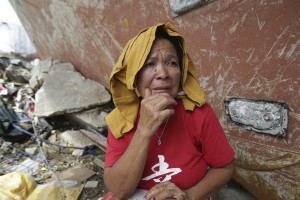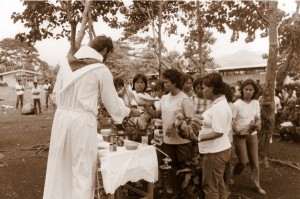Surviving a Typhoon: It's Part of Missionary Life in the Philippines
The Franciscan friars of the Province of St. John the Baptist have been serving the people of the Philippines for over 60 years. Fr. Max Langenderfer, OFM, remembers a typhoon from 1985.

A survivor cries as she tells her ordeal beside a ship that was washed ashore in Tacloban city, Leyte province central Philippines on Monday, Nov. 11, 2013. The city remains littered with debris from damaged homes as many complain of shortage of food, water and no electricity since the Typhoon Haiyan slammed into their province. Haiyan, one of the most powerful typhoons ever recorded, according to U.S. Navy's Joint Warning Center, slammed into central Philippine provinces Friday leaving a wide swath of destruction and scores of people dead. (AP Photo/Aaron Favila)
In February 1985 the Biliran Island friars were on their way to Cebu for our annual retreat. We drove our two Isuzu utility vehicles from Kawayan to Naval to Biliran and then to Ormoc where we usually took the ferry to Cebu City via Mactan Island and the Cebu harbor. This time, however, the sea was too rough because of an approaching typhoon and the ferry company had delayed the crossing because of the rough seas.
Instead of waiting for the ferry we decided to go to Tacloban and try to get a flight to Cebu. As usual we stayed with the Redemptorists at their Tacloban parish convento. We were too late to get a flight so we had to stay the night in the two-story concrete house of the Redemptorists.
During the night the typhoon made landfall. The screeching of the wind increased as the night wore on and the rain came through the glass louver windows on the south side of the building. The Redemptorist house was set back from the main street of Tacloban on a large lot. The house was slightly in front and to the side of a large concrete church. Across the main street were the usual densely packed bamboo houses of the local fishermen and city people. Many of the houses had nipa roofs and some had tin or GI sheets. A few houses had cement block walls with tin roofs. Many were built on the traditional stilts above the sand of the baybay or seashore.
As the winds increased we would hear the metallic rip as the tin sheets were torn off the roofs and crashed into nearby structures. While the glass louvers were tightly closed the force of the wind drove the rain through the cracks in a constant shower. While the wind came from the south we stayed in the rooms on the north side of the building. As the night wore on and the eye passed, the wind then came from the north side with the accompanying shower and we moved to the rooms on the south side. The floors were all concrete and so the accumulating rain water ran down the steps to the first floor.
With the first light of morning the typhoon had passed, and we went downstairs and outside to see the results. The yard was covered with all sorts of debris: tree limbs, banana plants, mangled tin, pieces of board, and all sorts of clothing and plastic house wares. The houses across the road were simply a massive heap of debris. The power lines and poles which formerly followed along the side of the main road were now neatly lying across the length of the main street.
One of us had come on a Yamaha 100 from Naval and Fr. Sam Hermes decided to see if he could make it back to Naval to access the damage to the parish. Sam made it as far as Carigara where the bridge had been washed away and people were crossing the river on a single coconut trunk. The next day Randy Berning, a lay volunteer, tried it and made it to Naval somehow but the Yamaha was never the same. I think we waited another day before we were able to get a flight to Cebu.
By the time we returned to Naval much of the debris had been cleaned up. The electric lines which only a few months earlier had brought the first current to Naval were all down in a shambles. It would be some more months before the Bileco electric company could restore service. Our Naval convento and church were not seriously damaged. A huge acacia tree at the corner of the garage was now lying across the yard to the house. The roof of the kindergarten school building had been blown off and across the plaza towards the sea. It took some months and most of the parish savings to repair the kinder roof.
Bonifacio, the gardener, had built a new bamboo and nipa house at the edge of town. It had collapsed completely and he was now living in the section of roof sitting neatly on the ground. Most of the lube, coconut palm trees, were standing on the hillsides like matchsticks with the tops blown off and only the trunks remaining. Banana stalks were lying everywhere.
Many of the photos coming from CNN and BiliranIsland.com are very familiar. What is truly disturbing is the massive destruction of entire blocks of houses on a peninsula in Tacloban not so close to the seaside. The photos are similar to the destruction of the December 26 tsunami in Indonesia. Even more distressing is the reports of looting and violence in Tacloban which I do not remember happening after other typhoons. What I remember is the sense of solidarity as everyone pitched in to clean up and repair their neighborhoods and villages. The Biliran town church built by Fr. Elwin Harrington has lost its roof and part of one side wall. It may well be a total loss.
Srs. Daina and Emma, two of the Franciscan Sisters Pro Infante and Familia who had been living in one of the totally destroyed areas, have been found alive and are on their way to their motherhouse in Talamban, Cebu. We have no news about the five FSPIF sisters living in Naval. For now all we can do is pray. In the future the people of Leyte and Biliran will need massive amounts of assistance to rebuild their homes, parishes, and lives.
---Fr. Max
Fr. Max Langenderfer, OFM, has served as a Franciscan missionary to people around the world. He currently is the pastor of St. Joseph Church in Savannah-la-Mar, Jamaica.
 By the grace of God, our missionaries in the Philippines survived Typhoon Haiyan, one of the most devastating storms in history.
By the grace of God, our missionaries in the Philippines survived Typhoon Haiyan, one of the most devastating storms in history.
But tens of thousands lost everything they own – and in many cases, everyone they love. Just as they have since 1956, our Franciscan friars will be working to support and sustain those who are most in need.
With your help and their efforts, we can give the people of the Philippines a reason to hope, and the means to rebuild. Please donate whatever you can to our relief efforts. Please remember to select “Philippines” on the drop down when asked how you would like your gift used.


